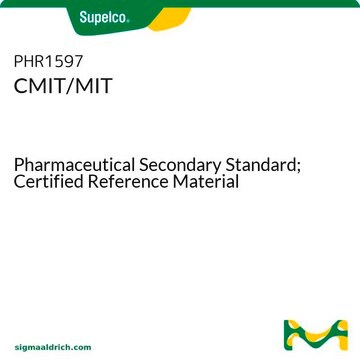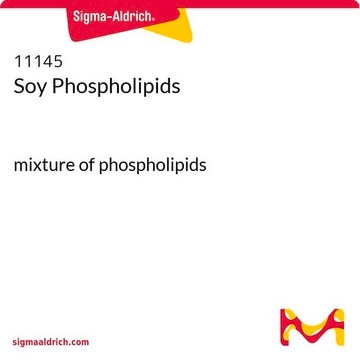725765
2-Methyl-4-isothiazolin-3-one
95%
Synonim(y):
2-Methyl-3(2H)-isothiazolone
About This Item
Polecane produkty
Próba
≥94.0% (GC)
95%
Postać
lumps
zanieczyszczenia
≤5% water
ciąg SMILES
CN1SC=CC1=O
InChI
1S/C4H5NOS/c1-5-4(6)2-3-7-5/h2-3H,1H3
Klucz InChI
BEGLCMHJXHIJLR-UHFFFAOYSA-N
Szukasz podobnych produktów? Odwiedź Przewodnik dotyczący porównywania produktów
Zastosowanie
- Insights into the mechanisms of within-species variation in sensitivity to chemicals: A case study using daphnids exposed to CMIT/MIT biocide.: This study investigates the differential sensitivity of daphnids to 2-Methyl-4-isothiazolin-3-one, highlighting the biochemical mechanisms underlying these variations. The findings provide crucial insights for environmental safety assessments (Kim et al., 2023).
- Effects of the biocide methylisothiazolinone on Xenopus laevis wound healing and tail regeneration.: The study assesses the impact of 2-Methyl-4-isothiazolin-3-one on regenerative processes in amphibians, contributing to the understanding of its biological effects and potential toxicity (Delos Santos et al., 2016).
- T cell lymphomatoid contact dermatitis: a challenging case and review of the literature.: This review includes discussions on 2-Methyl-4-isothiazolin-3-one-induced contact dermatitis, providing valuable information for dermatological applications and safety assessments (Knackstedt and Zug, 2015).
Hasło ostrzegawcze
Danger
Zwroty wskazujące rodzaj zagrożenia
Zwroty wskazujące środki ostrożności
Klasyfikacja zagrożeń
Acute Tox. 2 Inhalation - Acute Tox. 3 Dermal - Acute Tox. 3 Oral - Aquatic Acute 1 - Aquatic Chronic 1 - Eye Dam. 1 - Skin Corr. 1B - Skin Sens. 1A
Zagrożenia dodatkowe
Kod klasy składowania
6.1A - Combustible acute toxic Cat. 1 and 2 / very toxic hazardous materials
Klasa zagrożenia wodnego (WGK)
WGK 3
Temperatura zapłonu (°F)
Not applicable
Temperatura zapłonu (°C)
Not applicable
Środki ochrony indywidualnej
dust mask type N95 (US), Eyeshields, Faceshields, Gloves, type P3 (EN 143) respirator cartridges
Certyfikaty analizy (CoA)
Poszukaj Certyfikaty analizy (CoA), wpisując numer partii/serii produktów. Numery serii i partii można znaleźć na etykiecie produktu po słowach „seria” lub „partia”.
Masz już ten produkt?
Dokumenty związane z niedawno zakupionymi produktami zostały zamieszczone w Bibliotece dokumentów.
Klienci oglądali również te produkty
Nasz zespół naukowców ma doświadczenie we wszystkich obszarach badań, w tym w naukach przyrodniczych, materiałoznawstwie, syntezie chemicznej, chromatografii, analityce i wielu innych dziedzinach.
Skontaktuj się z zespołem ds. pomocy technicznej











